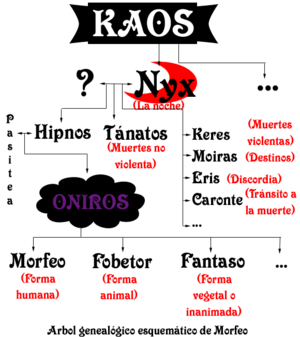Morpheus
In Greek mythology, Morpheus (in ancient Greek Μορφεύς, from μορφή morphê, 'form') is the god of dreams, son of the personification of dreams (Hypnos), and in charge of bringing dreams to kings and emperors. According to certain ancient theogonies, he is the chief of the Oniros, the thousand children begotten by Hypnos (Dream) and Nix (Night, his mother), or by Hypnos with Pasitea.
He was represented with wings that beat quickly and silently, allowing him to go to any corner of the Earth. Morpheus was in charge of inducing the dreams of those who slept and of adopting a human appearance to appear in them, especially that of loved ones (hence his name), allowing mortals to flee for a moment from the machinations of the gods.
He was punished by Zeus for revealing secrets to mortals through his dreams. From his name comes the expression "to be in the arms of Morpheus", which means "to dream" and by extension "to sleep" or vice versa.
Greek doctors worshiped Morpheus especially in the sanctuaries of the great oracles and in the temples of Asclepius, god of medicine, where he was invoked through complex rituals involving baths, fasting, burning incense, music and songs that induce sleep.
Different myths about Morpheus
- According to certain ancient theogonies, it is the main of the Oniros, the thousand sons begotten by Hipnos (the Dream) and Nix (the Night, his mother), or by Hipnos with Pasitea.
- Morpheus plays an important role in the history of Ceix and Alcíone. Ceix was married to Alcione. In a version of the myth, Ceix went to Claros (Jonia) to consult an oracle, but it was wrecked during the journey, drowning. Hera entrusted her messenger, the goddess Iris to Morpheus to tell the news to Alcíone through a dream. Knowing of the death of her husband by Morpheus, Alcíone threw himself into the sea. Praying for them, the gods transformed the couple into fishermen's rallies or wings.
- Other authors make them children of Nix and Erebo.
- According to other myths, he was begotten by Hipnos with Pasítea.
- It appears in works by Homero and Ovid. The latter account in Metamorphosis that Morpheus sleeps in an ebony bed in a subtly lit cave, surrounded by poppy flowers (which contain alkaloids of sedative and narcotic effects).
- Sometimes he introduced himself with human appearance in the dreams he created. It is also said that his brothers Fantaso and Fobetor accompanied him to complete dreams with things and animals, respectively.
Morpheus in different mythologies
In many cultures there are different figures that are similar to Morpheus, on certain occasions Hypnos and Morpheus are considered the same. In Anglo-Saxon culture, the Sandman is considered the representative figure of dreams. In Egyptian mythology, there was the god Tot and the god Tutu who represented dreams. In Japanese culture there were beings called Baku that ate nightmares and evil spirits. In Hinduism, the god Vishru appears, who among other things represents dreams.
Sculptures
- Morpheus by Jean-Antoine Houdon at the Louvre Museum.
- Morpheus of Nicolas Poussin in the garden meadow of the Palace of Versailles.
- God of sleep by anonymous author at the Museo del Prado
- Morpheus or Sleeping Love of José Álvarez Cubero
Paintings
- In the arms of Morpheus by William Reynolds Stephen
Fonts
- Ovid, Metamorphosis XI,583 and sig.
Contenido relacionado
Melia
Ratatosk
Cupid
